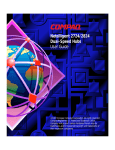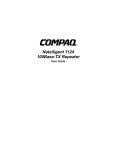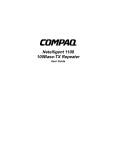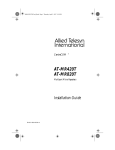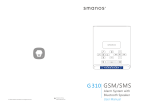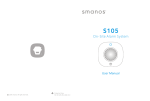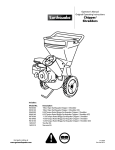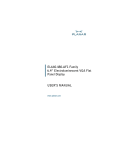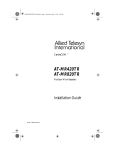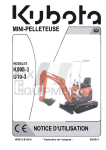Download Compaq Netelligent 1016 User guide
Transcript
Netelligent 1016 10Base-T Repeater User Guide . . . . . . . . . . . . . . . . . . . . . . . . . . . . . NOTICE The information in this publication is subject to change without notice. COMPAQ COMPUTER CORPORATION SHALL NOT BE LIABLE FOR TECHNICAL OR EDITORIAL ERRORS OR OMISSIONS CONTAINED HEREIN, NOR FOR INCIDENTAL OR CONSEQUENTIAL DAMAGES RESULTING FROM THE FURNISHING, PERFORMANCE, OR USE OF THIS MATERIAL. This publication contains information protected by copyright. No part of this publication may be photocopied or reproduced in any form without prior written consent from Compaq Computer Corporation. The software described in this guide is furnished under a license agreement or non disclosure agreement. The software may be used or copied only in accordance with the terms of the agreement. Product names mentioned herein may be trademarks and/or registered trademarks of their respective companies. 1996 Compaq Computer Corporation. All rights reserved. Printed in the U.S.A. Compaq Registered United States Patent and Trademark Office. Netelligent is a trademark of Compaq Computer Corporation. Microsoft and Windows are a registered trademarks of Microsoft Corporation. Compaq Netelligent 1016 10Base-T Unmanaged Repeater User Guide First Edition (July 1996) Part Number 268749-001 Writer: Liz Fischer Project: Comments: 268749-001 File Name:749_n1.doc Last Saved On:6/19/96 10:51 AM . . . . . . . . . . . . . . . . . . . . . . . . . . . . . v Federal Communications Commission Notice Part 15 of the Federal Communications Commission (FCC) Rules and Regulations has established Radio Frequency (RF) emission limits to provide an interference-free radio frequency spectrum. Many electronic devices, including computers, generate RF energy incidental to their intended function and are, therefore, covered by these rules. These rules place computers and related peripheral devices into two classes, A and B, depending upon their intended installation. Class A devices are those that may reasonably be expected to be installed in a business or commercial environment. Class B devices are those that may reasonably be expected to be installed in a residential environment (i.e., personal computers). The FCC requires devices in both classes to bear a label indicating the interference potential of the device as well as additional operating instructions for the user. The rating label on the device shows which class (A or B) the equipment falls into. Class B devices have an FCC ID on the label. Class A devices do not have an FCC ID on the label. Once the class of the device is determined, refer to the following corresponding statement. NOTE: If this equipment contains a Token Ring interface, this equipment is a Class A digital device when the Token Ring interface is utilized. Class A Equipment This equipment has been tested and found to comply with the limits for a Class A digital device, pursuant to Part 15 of the FCC Rules. These limits are designed to provide reasonable protection against harmful interference when the equipment is operated in a commercial environment. This equipment generates, uses, and can radiate radio frequency energy and, if not installed and used in accordance with the instructions, may cause harmful interference to radio communications. Operation of this equipment in a residential area is likely to cause harmful interference, in which case the user will be required to correct the interference at personal expense. Canadian Notice This Class A digital apparatus meets all requirements of the Canadian Interference-Causing Equipment Regulations. Avis Canadien Cet appareil numérique de la classe A respecte toutes les exigences du Règlement sur le matériel brouilleur du Canada. Compaq Netelligent 1016 10Base-T Unmanaged Repeater User Guide Writer: Liz Fischer Project: Federal Communications Commission Notice Comments: 268749-001 File Name:749_n2.doc Last Saved On:6/19/96 10:50 AM . . . . . . . . . . . . . . . . . . . . . . . . . . . . . . vi Federal Communications Commission Notice Modifications The FCC requires the user to be notified that any changes or modifications made to this device that are not expressly approved by Compaq Computer Corporation may void the user's authority to operate the equipment. Cables Connections to this device must be made with shielded cables with metallic RFI/EMI connector hoods in order to maintain compliance with FCC Rules and Regulations. Writer: Liz Fischer Project: Federal Communications Commission Notice Comments: 268749-001 File Name:749_n2.doc Last Saved On:6/19/96 10:50 AM . . . . . . . . . . . . . . . . . . . . . . . . . . . . . vii Euopean Union (EU) Notice Products with the CE Marking comply with both the EMC Directive (89/336/EEC) and the Low Voltage Directive (73/23/EEC) issued by the Commission of the European Community. Compliance with these directives implies conformity to the following European Norms (in brackets are the equivalent international standards): ■ EN55022 (CISPR 22) - Electromagnetic Interference ■ EN50082-1 (IEC801-2, IEC801-3, IEC801-4) - Electromagnetic Immunity ■ UL 1950, Second Edition; CAN/CSA C22.2 No. 950-93; TUV Rheinland EN 60950; and 1988 + A1/1990+A2/1991 - Product Safety Japanese Notice Compaq Netelligent 1016 10Base-T Unmanaged Repeater User Guide Writer: Liz Fischer Project: Federal Communications Commission Notice Comments: 268749-001 File Name:749_n2.doc Last Saved On:6/19/96 10:50 AM . . . . . . . . . . . . . . . . . . . . . . . . . . . . . . viii Federal Communications Commission Notice Fiber Port Class 1 Classification Compaq fiber ports have been tested in accordance with the IEC 825-1 test standard and found to meet the Class 1, intrinsically eye-safe emitter classification. Product Label . CLASS 1 LED KLASSE 1 LED The fiber ports on this product have been tested in accordance with the IEC 825-1 Test Standard and found to meet the Class 1, intrinsically eye-safe emitter classification. Lithium Battery The non-volatile RAM (NVRAM) chip on the motherboard of the Netelligent 5000 10/100 switch products contains a non-replaceable lithium battery. Only trained service personnel should dispose of this chip. La puce mémoire non volatile contient une pile au lithium non remplaçable. L'élimination de cette puce devrait être confieé à un personnel qualifié. Writer: Liz Fischer Project: Federal Communications Commission Notice Comments: 268749-001 File Name:749_n2.doc Last Saved On:6/19/96 10:50 AM . . . . . . . . . . . . . . . . . . . . . . . . . . . . . 1-1 Chapter 1 Overview The Compaq Netelligent 1016 10Base-T unmanaged repeater is the ideal connectivity solution for departmental Ethernet workgroups. It is easy to configure, maintain, and expand and is capable of port management via its built-in LED indicators. Features The Netelligent 1016 10Base-T repeater (Part Number 267025-001) has the following features: ■ Sixteen RJ-45 ports for connecting UTP or STP cabling to workstations and servers in a 10Base-T network ■ One Media Expansion Port (MEP) that supports optional Alternate Media Connectors, including the following types: ❏ AUI (DB-15) (Part Number 267063-001) ❏ BNC (Thinnet) (Part Number 267064-001) ❏ Fiber (10Base-FL) (Part Number 267065-001) ■ Front-panel uplink switch that converts Port 16 to an uplinkable port so the repeater can connect to another repeater in a star topology ■ LEDs that indicate power, activity, and collision status as well as activity on the RJ-45 ports ■ Link integrity feature that automatically partitions noisy segments and detects broken cable segments ■ Compatibility with the IEEE 802.3 10Base-T repeater specifications for connection to shielded or unshielded twisted-pair wiring Compaq Netelligent 1016 10Base-T Unmanaged Repeater User Guide Writer: Liz Fischer Project: Overview Comments: 268749-001 File Name:749_1.doc Last Saved On:6/19/96 10:46 AM . . . . . . . . . . . . . . . . . . . . . . . . . . . . . . 1-2 Overview Figure 1-1 shows the repeater's front and back panels and the locations of the various repeater components: Power/Activity/Collision Media Expansion Port LEDs Media Expansion Port PWR 1 2 3 RJ-45 Ports and LEDs 4 5 6 7 8 9 10 11 12 14 13 15 16 UPLINK ACT MDI COL MDI-X MEP Power Cord Connector UPLINK Switch (for converting Port 16 to an uplinkable port) Back Panel Figure 1-1. Front and Back Panels of the Repeater Figure 1-2 shows optional Altermate Media Connectors that you can install in the repeater's Media Expansion Port: Alternate Media Connectors (Optional) BNC Connector (Thinnet) AUI Connector Fiber Connector (10Base-FL) RX Figure 1-2. Alternate Media Connectors Writer: Liz Fischer Project: Overview Comments: 268749-001 File Name:749_1.doc Last Saved On:6/19/96 10:46 AM TX . . . . . . . . . . . . . . . . . . . . . . . . . . . . . 1-3 LED Indicators The repeater contains PWR, ACT, COL, and MEP LEDs that show the repeater's power status (ON or OFF), the incoming traffic on the repeater (heavy, light, or no activity), and the collision status (light or heavy activity). Each RJ-45 port has a Link Status LED that operates in the following manner: ■ When you power up the repeater, the Link Status LEDs are ON momentarily, then turn OFF. ■ When the repeater connects with either a powered network station or another repeater, the LED associated with that port is ON and remains ON until the connection breaks. ■ If the repeater makes no connection, the LED is OFF. Figure 1-3 shows the locations of the LEDs and the RJ-45 ports on the front panel of the repeater. Power, Activity, Collision, Media Expansion Port Activity LEDs Link Status LEDs PWR 1 2 3 4 5 6 7 8 9 10 11 12 13 14 15 16 ACT COL MEP RJ-45 Ports Figure 1-4. Location of the LEDs Compaq Netelligent 1016 10Base-T Unmanaged Repeater User Guide Writer: Liz Fischer Project: Overview Comments: 268749-001 File Name:749_1.doc Last Saved On:6/19/96 10:46 AM . . . . . . . . . . . . . . . . . . . . . . . . . . . . . . 1-4 Overview Table 1-1 describes the repeater LEDs: Table 1-1 LED Indicators LED Flashing Yellow Green Flashing Green LED OFF PWR Not used Power ON; normal operations Not used Power OFF ACT Not used Heavy activity (incoming traffic) on the port Light activity (incoming traffic) on the port No activity (no incoming traffic on port) COL * Not used Not used No collisions * Slow flashing = Light collisions; Fast flashing = Heavy collisions Link Status (RJ-45 Port) Not used Link OK for the RJ-45 port Not used NOTE: Flashing Yellow LEDs may appear orange on the repeater’s front panel. Writer: Liz Fischer Project: Overview Comments: 268749-001 File Name:749_1.doc Last Saved On:6/19/96 10:46 AM Link failed or no connection for the RJ-45 port . . . . . . . . . . . . . . . . . . . . . . . . . . . . . 1-5 Package Contents Before you start, verify that this package contains the following items: ■ Netelligent 1016 10Base-T repeater (Part Number 267025-001) ■ Compaq Netelligent 1016 10Base-T Unmanaged Repeater User Guide ■ Power cord ■ Two rack mounting brackets ■ Four screws for rack mounting (#10-32X1/2) and two screws for the media expansion port (#4-40X1/4) ■ (Optional) Alternate Media Connectors ■ ❏ AUI DB-15 (Part Number 267063-001) ❏ BNC for Thinnet (Part Number 267064-001) ❏ Fiber 10Base-FL (Part Number 267065-001) Warranty card Compaq Netelligent 1016 10Base-T Unmanaged Repeater User Guide Writer: Liz Fischer Project: Overview Comments: 268749-001 File Name:749_1.doc Last Saved On:6/19/96 10:46 AM . . . . . . . . . . . . . . . . . . . . . . . . . . . . . 2-1 Chapter 2 Media Expansion Options The repeater contains a Media Expansion Port (MEP) that gives you the option of installing one of several Alternate Media Connectors (AMCs) to expand the network to other media. Each connector is sold separately. This chapter describes these connectors and how to install each. Alternate Media Connectors You can use the following AMCs with the repeater: ■ AUI wiring for DB-15 Thicknet backbone (Part Number 267063-001) ■ BNC for Thinnet backbone (Part Number 267064-001) ■ Fiber 10Base-FL backbone (Part Number 267065-001) These are shown in Figure 2-1: BNC Connector (Thinnet) AUI Connector Fiber Connector (10Base-FL) RX TX Figure 2-1. Alternate Media Connectors Installing a BNC Alternate Media Connector To connect the repeater to a Thinnet backbone, use a BNC connector. If you install a BNC connector but do not physically connect a cable to it, be sure to disable the port by setting the jumper on the connector board. Figure 2-2 shows the jumper settings on the board. You can also use an external terminator on this port. If you use a terminator, set the jumper to ON so that you can make connections to this port later. Compaq Netelligent 1016 10Base-T Unmanaged Repeater User Guide Writer: Liz Fischer Project: Media Expansion Options Comments: 268749-001 File Name:749_2.doc Last Saved On:6/19/96 11:07 AM . . . . . . . . . . . . . . . . . . . . . . . . . . . . . . 2-2 Media Expansion Options IMPORTANT: If there is no connection or external terminator at the BNC port, set the jumper to the OFF position. Otherwise, excessive collisions will occur and adversely affect network performance. The AW1 jumper settings are shown in Figure 2-2: ON AW1 BNC Disabled OFF BNC Enabled (Default) Figure 2-2. AW1 Jumper Settings To install a BNC connector, follow these steps: 1. Power down the repeater if it is currently operating For information about disconnecting power, see the section “Disconnecting Power” in Chapter 3 of this guide. 2. Remove the cover from the repeater's Media Expansion Port. 3. Check that the jumpers on the BNC board are set correctly (ON for connection; OFF for no connection). Writer: Liz Fischer Project: Media Expansion Options Comments: 268749-001 File Name:749_2.doc Last Saved On:6/19/96 11:07 AM . . . . . . . . . . . . . . . . . . . . . . . . . . . . . 2-3 4. Insert the BNC connector through the MEP opening and carefully push the 20-pin plug into the outlet on the repeater board until the AMC is secure. 5. Tighten the screws on the faceplate. 6. Restart the repeater. For information about starting the repeater, see the section “Connecting Power” in Chapter 3 of this guide. If you have connected the repeater properly, the link status LED above each RJ-45 port turns ON momentarily, then turns OFF. Installing an AUI or Fiber Alternate Media Connector To connect the repeater to a Thicknet backbone, use an AUI connector. To connect the repeater to a 10Base-FL backbone, use a fiber connector. The AUI and Fiber connectors require no jumper settings. To install either AUI or Fiber connectors, follow these steps: 1. Power down the repeater if it is currently operating. 2. Remove the cover from the repeater's Media Expansion Port. 3. Insert the AMC's connector through the MEP opening, and carefully push the 20-pin male connector into the receptacle on the repeater board until the connector is secure. 4. Tighten the screws on the faceplate. 5. Restart the repeater. If you have connected the repeater properly, the link status LED above each RJ-45 port turns ON momentarily, then turns OFF. Compaq Netelligent 1016 10Base-T Unmanaged Repeater User Guide Writer: Liz Fischer Project: Media Expansion Options Comments: 268749-001 File Name:749_2.doc Last Saved On:6/19/96 11:07 AM . . . . . . . . . . . . . . . . . . . . . . . . . . . . . 3-1 Chapter 3 Setting Up the Repeater This chapter describes the requirements for setting up the repeater, including environmental, electrical, and spatial requirements, as well as UTP cabling considerations. The chapter also explains how to rack mount and power up the repeater, how to make a basic repeater-to-workstation connection, and how to set up some basic network configurations. Selecting a Location You can place the repeater on a level surface (a desktop or cabinet, for example) or mount it in a 19-inch rack using a rack mount kit. Environmental Requirements For environmental requirements, see Appendix A, “Technical Specifications” in this guide. Electrical Requirements The power source must be a non-switched, three-pronged, grounded outlet. CAUTION: Do not use a three-to-two pronged adapter at the outlet. Doing so may result in electrical shock and/or damage to the repeater. The electrical requirements for a repeater are as follows: Table 3-1 Repeater Electrical Requirements Voltage 100 to 240 VAC Frequency 50 to 10 Hz Power 0.30 to 0.15 Amps maximum Compaq Netelligent 1016 10Base-T Unmanaged Repeater User Guide Writer: Liz Fischer Project: Setting Up the Repeater Comments: 268749-001 File Name:749_3.doc Last Saved On:6/25/96 9:30 AM . . . . . . . . . . . . . . . . . . . . . . . . . . . . . . 3-2 Setting Up the Repeater Data communications equipment is sensitive to variations in voltage supplied by AC power supplies. Overvoltage, undervoltage, or transients can interfere with data integrity and may damage your equipment. CAUTION To protect against these voltage-related problems, power cables should be properly grounded and the following power management methods should be employed: • Use power protection devices. Various levels of protection can be achieved by the use of surge protectors, line conditioners, and uninterruptible power supplies. • Place the equipment on a dedicated circuit. • If a blackout occurs while your equipment is turned on, immediately turn off the system (if the unit is equipped with a power switch) and disconnect it from the power source. Leaving the system on and plugged in under these power conditions may damage the equipment when power is restored. • Turn off the equipment and unplug it during lightning storms. Spatial Requirements The repeater's dimensions are 1.75 x 17.4 x 8.3 inches, 4.5 x 44.8 x 21.3 centimeters (HxWxD). When you set the repeater on a level surface, allow at least 2 inches (5.1 cm) on each side of the repeater for proper air circulation. Rack-Mounting the Repeater To rack-mount one or more repeaters, follow these steps: 1. Before you install any repeater, secure the rack to the floor, another rack, or the wall. 2. Turn the repeater over so that the bracket slots are easily accessible. Writer: Liz Fischer Project: Setting Up the Repeater Comments: 268749-001 File Name:749_3.doc Last Saved On:6/25/96 9:30 AM . . . . . . . . . . . . . . . . . . . . . . . . . . . . . 3-3 3. To install the brackets in the repeater, insert the bracket clips into the bracket slots on the bottom of the repeater. The brackets rest flat against the bottom and the sides of the repeater, while the mounting holes that secure the bracket to the rack face the front of the repeater. To flushmount the repeater, use Slots 1 and 3 (see Figure 3-1). To have the repeater extend slightly out of the rack, use Slots 2 and 4. 4. Push the bracket back until you feel it snap over the plastic ridge inside the mounting slot. Figure 3-1 shows the installation of the brackets in the repeater. Right Bracket Bracket Clips Left Bracket 3 2 1 1 4 5 6 7 8 9 10 11 12 13 14 15 2 3 4 Bottom of Repeater 2 16 Right Bracket Slots 3 1 4 Left Bracket Slots Figure 3-1. Installing the Mounting Brackets in the Repeaters 5. Turn the repeater face up. 6. Select the height at which you want to install it in the rack and align the right and left mounting brackets with a matching hole pattern. Position the brackets on the inside of the wall rack. 7. Fasten the mounting brackets to the wall rack using the four screws provided. To remove the repeater from the rack, follow these steps: 1. Leave the repeater on the mounting brackets and unscrew the mounting brackets from the rack. Be sure to support the repeater during this procedure so that it does not fall from the rack. Compaq Netelligent 1016 10Base-T Unmanaged Repeater User Guide Writer: Liz Fischer Project: Setting Up the Repeater Comments: 268749-001 File Name:749_3.doc Last Saved On:6/25/96 9:30 AM . . . . . . . . . . . . . . . . . . . . . . . . . . . . . . 3-4 Setting Up the Repeater 2. To remove a bracket from the repeater, pull the bracket forward until it unsnaps from the plastic ridge inside the mounting slot. Connecting Power To connect the repeater to power, follow these steps: 1. Plug the female IEC connector of the power cord into the power cord outlet on the back of the repeater. 2. Insert the three-pronged plug on the power cord into an appropriate power source as shown in Figure 3-2 (see also the Caution under “Electrical Requirements” in the section “Selecting a Location” in this chapter). The power source should be near the repeater and easily accessible (within the 6-foot, 1.8-meter, cord distance). When you plug in the power cord, all LEDs on the front panel are momentarily ON, which confirms the repeater is operating correctly. IMPORTANT: The repeater has no power switch. It receives power via the power cord connection. Disconnecting the Repeater from the Power Source Should you need to power down the repeater, you will need to properly disconnect it from the power source. To power down the repeater, remove the plug from the grounded power source (such as the wall outlet or power strip) and not from the outlet on the back of the unit. The female plug on the power cord is not a certified disconnect. Writer: Liz Fischer Project: Setting Up the Repeater Comments: 268749-001 File Name:749_3.doc Last Saved On:6/25/96 9:30 AM . . . . . . . . . . . . . . . . . . . . . . . . . . . . . 3-5 Do Remove the Power Plug from the Grounded Power Source Don’t Figure 3-2. Properly Disconnecting Power Cabling Considerations This section outlines twisted-pair wire specifications and describes how to make a simple direct connection between a repeater and a workstation. Twisted-Pair Wire Specifications The twisted-pair wiring must meet the following minimum specifications and requirements to ensure long-term LAN reliability. If the wiring does not meet these specifications and requirements, you may need to install new twisted-pair wiring. ■ Shielded or unshielded twisted-pair (STP or UTP) ■ Two pairs of wires ■ Depending on building codes, different insulation materials (Plenumrated or Teflon-coated wiring may be required in some areas.) ■ UTP wire specifications: ❏ Solid copper ❏ Nominal capacitance: Less than 16pF/foot ❏ Nominal impedance: 100 Ohms Compaq Netelligent 1016 10Base-T Unmanaged Repeater User Guide Writer: Liz Fischer Project: Setting Up the Repeater Comments: 268749-001 File Name:749_3.doc Last Saved On:6/25/96 9:30 AM . . . . . . . . . . . . . . . . . . . . . . . . . . . . . . 3-6 Setting Up the Repeater ❏ Nominal attenuation: Less than 11.5db ❏ Wire gauge between 18 and 26 AWG ■ Maximum distance requirement 328 feet (100 meters). This distance must include all cross-connect wire, wire in the walls, and any drop cables from wall plates to workstations (see the next section to determine the proper length). Maximum distances may be less for UTP cable run underground, in conduit, or in large cable bundles. ■ Wiring in good condition with the insulation not frayed or worn IMPORTANT: Never use gray satin station cable for connecting a repeater. This flat cable, typically used for connecting telephones to wall jacks, is incompatible with 10Base-T systems. The repeater is compatible with all AT&T Type D wiring (D-Inside wiring) and AT&T PDS wiring. You can also use IBM Type 1 wiring (with two inside conductors). Two types of D-Inside wiring will work with the repeater: DW8 Uses stranded wires and is relatively flexible; is best for shorter runs (less than 50 feet, 16.2 meters) within the same room D8W Uses solid conductors and is less flexible; is best for longer runs through ceilings and/or walls A modular cord consists of D-Inside wiring with RJ-45 plugs on each end. The connection between a repeater and a workstation consists of four pairs of straight-through, D-Inside wiring (the repeater uses only two pairs), as shown in Figure 3-3: Writer: Liz Fischer Project: Setting Up the Repeater Comments: 268749-001 File Name:749_3.doc Last Saved On:6/25/96 9:30 AM . . . . . . . . . . . . . . . . . . . . . . . . . . . . . 3-7 Brown-White White-Brown Green-White Blue-White White-Blue White-Green Orange-White White-Orange 8 7 6 5 4 3 2 1 1 2 3 4 5 6 7 8 White-Orange Orange-White White-Green White-Blue Blue-White Green-White White-Brown Brown-White Figure 3-3. D-Inside Wire The cable in Figure 3-4 shows how the wire connected to Pin 1 must be twisted with the wire connected to Pin 2, and the wire connected to Pin 3 must be twisted with the wire connected to Pin 6. Pins 4, 5, 7, and 8 are reserved for telephone and other services. Plug Pin # 1 2 Transmit Pair Plug Pin # 1 2 Receive Pair 3 6 3 6 Figure 3-4. Receive/Transmit Pair Each RJ-45 jack on the repeater has the 10Base-T standard pin-out shown below. A straight-through cable using the pair combinations below provides the appropriate 10Base-T connection between the repeater and the workstation. Table 3-2 10Base-T Pin-Out 1 TD+ 2 TD- 3 RX+ 6 RX- Compaq Netelligent 1016 10Base-T Unmanaged Repeater User Guide Writer: Liz Fischer Project: Setting Up the Repeater Comments: 268749-001 File Name:749_3.doc Last Saved On:6/25/96 9:30 AM . . . . . . . . . . . . . . . . . . . . . . . . . . . . . . 3-8 Setting Up the Repeater Repeater-to-Workstation Connection To connect the repeater to a workstation, follow these steps: 1. Plug one end of the modular cord into a 10Base-T-equipped workstation. 2. Plug the other end of the modular cord directly into the desired port on the repeater, as shown in Figure 3-5. The maximum end-to-end cable distance is 328 feet (100 meters). Media Expansion Port PWR 1 2 3 4 5 6 7 8 9 10 11 12 13 14 15 16 UPLINK ACT MDI COL MDI-X MEP X 10Base-T-Equipped Workstation Figure 3-5. Repeater-to-Workstation Connection After you connect the workstation to the repeater and power on both units, the repeater's PWR LED and the LED that corresponds to the connected port should be ON. If the LEDs are OFF, verify that the connections are correct. Writer: Liz Fischer Project: Setting Up the Repeater Comments: 268749-001 File Name:749_3.doc Last Saved On:6/25/96 9:30 AM . . . . . . . . . . . . . . . . . . . . . . . . . . . . . 3-9 Setting the Uplink Switch The uplink switch on the front panel of the repeater converts Port 16 to an uplinkable port. This feature allows the repeater to connect to another repeater in a star topology. The default setting for the uplink switch is MDI-X (the standard RJ-45 port). The uplink switch helps simplify twisted-pair wiring between repeaters. Typically, the repeater's RJ-45 jacks function as input ports for workstation connections. Connecting an input port from one repeater to an input port of another repeater normally requires a special crossover cable that reverses the receive and transmit pairs. However, the repeater's uplink switch eliminates the need for crossover cables by reconfiguring Port 16 as an output port. Figure 3-6 shows the proper position for the uplink switch when connecting Port 16 to a primary repeater. To change the switch to the desired position, use a small, slotted screwdriver or a similar tool. Uplinkable "OUT" Port UP LINK MDI MDI-X Standard "IN" Repeater Port (Default) 16 UP LINK MDI MDI-X Figure 3-6. Setting the Uplink Switch Compaq Netelligent 1016 10Base-T Unmanaged Repeater User Guide Writer: Liz Fischer Project: Setting Up the Repeater Comments: 268749-001 File Name:749_3.doc Last Saved On:6/25/96 9:30 AM . . . . . . . . . . . . . . . . . . . . . . . . . . . . . . 3-10 Setting Up the Repeater Sample Network Configurations The following figures represent network configurations for a repeater LAN. Single Repeater Configuration Figure 3-7 shows one repeater connected to network stations within a 328 foot (100 meter) radius. You can place the repeater in a wiring closet or next to network stations. In this example, Port 16 of the repeater is configured as an input port to accommodate a workstation connection. To additional nodes Workstation Workstation Figure 3-7. Repeater-to-Workstation Connection Multiple Repeater Configuration Figure 3-8 shows three repeaters connected with unshielded twisted-pair wiring to form a larger network. The maximum distance between any two repeaters is 328 feet (100 meters). ■ Repeater A is the primary repeater to which you uplink Repeaters B and C. ■ Repeater B and Repeater C are uplinked to Repeater A (uplink switch is set to the MDI position). ■ Repeater B and Repeater C each have Port 16 configured as output ports. Writer: Liz Fischer Project: Setting Up the Repeater Comments: 268749-001 File Name:749_3.doc Last Saved On:6/25/96 9:30 AM . . . . . . . . . . . . . . . . . . . . . . . . . . . . . 3-11 Repeater A (Primary Repeater to which Repeaters B and C are uplinked)) Repeater C Repeater B UPLINK SWITCH (MDI Position) Figure 3-9. Multiple-Repeater Connection Compaq Netelligent 1016 10Base-T Unmanaged Repeater User Guide Writer: Liz Fischer Project: Setting Up the Repeater Comments: 268749-001 File Name:749_3.doc Last Saved On:6/25/96 9:30 AM . . . . . . . . . . . . . . . . . . . . . . . . . . . . . . 3-12 Setting Up the Repeater Maximum Repeater Path Model Ethernet limits the total number of repeaters that can be in the path between any two nodes (workstations and servers). Up to four repeaters can exist between two nodes. Figure 3-10 shows an example of the maximum repeater path and the maximum number of connections in that path. IMPORTANT: The following example is intended only to illustrate the maximum number of connections available for a repeater path. It does not represent a recommended configuration. For example, a maximum network configuration could contain 450 nodes (15 nodes on 15 repeaters = 225 nodes uplinked to one repeater; and 15 nodes on 15 repeaters = 225 nodes uplinked to a second repeater; 450 nodes total) and 32 repeaters. To Additional Repeaters To Additional Repeaters To Additional Nodes To Additional Nodes Workstation Server Maximum of 4 Repeaters Between Any Two Nodes Figure 3-10. Maximum Repeater Path Connection Writer: Liz Fischer Project: Setting Up the Repeater Comments: 268749-001 File Name:749_3.doc Last Saved On:6/25/96 9:30 AM . . . . . . . . . . . . . . . . . . . . . . . . . . . . . A-1 Appendix A Technical Specifications This appendix describes the technical specifications for the repeater. Electrical Specifications Connectors ■ Sixteen RJ-45 connectors for UTP/STP wiring ■ Optional Media Expansion Port (MEP) ■ IEC 320 power connector ■ Optional inline Alternate Media Connectors (AMCs) of the following types: ❏ BNC connector for Thinnet ❏ DB-15 AUI connector ❏ One pair of 10Base-FL ST connectors LED Indicators ■ Power (PWR) ■ Activities (ACT) ■ Collision (COL) status ■ Media Expansion Port (MEP) ■ RJ-45 port activity Compaq Netelligent 1016 10Base-T Unmanaged Repeater User Guide Writer: Liz Fischer Project: Technical Specifications Comments: 268749-001 File Name:749_a.doc Last Saved On:6/19/96 10:53 AM . . . . . . . . . . . . . . . . . . . . . . . . . . . . . . A-2 Technical Specifications Power Requirements ■ 100 to 240 VAC, 50 to 60 Hz ■ Power Consumption: ❏ Typical: 7W ❏ Maximum: 11W Environmental Specifications Operating Environment ■ 32° to 120° F; 0° to 49° C ■ 5% to 95% humidity (non-condensing) Storage Environment ■ 32° to 151° F; 0° to 66° C ■ 5% to 95% humidity (non-condensing) ■ 0 to 30,000 feet altitude; 0 to 9 kilometers ■ Convection Cooling Physical Specifications ■ 1.75 x 17.4 x 8.3 inches or 4.45 x 43.00 x 21.34 centimeters (HxWxD) Writer: Liz Fischer Project: Technical Specifications Comments: 268749-001 File Name:749_a.doc Last Saved On:6/19/96 10:53 AM . . . . . . . . . . . . . . . . . . . . . . . . . . . . . G-1 Glossary 10Base-2 An IEEE Standard (802.3) for local area networks. Complying networks must be able to carry information at a rate of 10 Mb/s over distances up to 606 feet (185 meters) of thin coaxial cable. 10Base-5 An IEEE Standard (802.3) for local area networks. Complying networks must be capable of carrying information at a rate of 10 Mb/s over distances up 1640 feet (500 meters) of thick coaxial cable. 10Base-T An IEEE Standard (802.3) for local area networks. Complying networks must be able to carry information at a rate of 10 Mb/s over distances up to 328 feet (100 meters) of unshielded twisted-pair cable. 66-Type Wiring Environment Also called Premises Distribution System (PDS). The AT&T wiring system in which the telephone nodes and other communications devices connect to the crossconnect block. 110-Type Wiring Environment Also called Premises Distribution Systems (PDS). The AT&T wiring system in which the telephone nodes and other communications devices can be easily added and rearranged with modular wiring components and patch cords. 802.3 An IEEE standard for Ethernet local area networks based on Carrier Sense Multiple Access with Collision Detection (CSMA/CD), which includes 10Base-2, 10Base-5, and 10Base-T. Adapter A device that supports the interconnection of different sizes and/or types of plugs. Attachment Unit Interface (AUI) The interface between the medium attachment unit (MAU) and a node within a local area network (LAN). Compaq Netelligent 1016 10Base-T Unmanaged Repeater User Guide Writer: Liz Fischer Project: Glossary Comments: 268749-001 File Name:749_g.doc Last Saved On:6/19/96 10:52 AM . . . . . . . . . . . . . . . . . . . . . . . . . . . . . . G-2 Glossary Backplane The data bus connections that interconnects different communication modules inside a network concentrator. BNC A thin Ethernet coax connector. Bridged Tap (Stub) A cable (or cord) connected to another cable (or cord) at a point other than its end. Such a tap causes impairment of network signal transmissions. Carrier Sense The monitoring of a local area network by a node to determine if another node is transmitting. Coaxial Cable A cable with at least one transmission line consisting of two conductors, an inner conductor, and an outer conductor insulated from one another by a dielectric. Coaxial cable carriers higher frequencies than twisted pair cable and offers a broader bandwidth. It commonly transmits video signals, but can also be used for certain high-speed data applications. Collision A condition that occurs when two nodes attempt to transmit on the network at the same time. When a collision occurs, both nodes recognize the collision stop transmission wait for a random time interval and then attempt to retransmit. Concentrator A device that provides connectivity between data terminals in a network. Conductor A medium such as copper wire that can carry electrical current. Configuration The layout of nodes and components in the network. Dielectric A substance that does not conduct electrical current. Writer: Liz Fischer Project: Glossary Comments: 268749-001 File Name:749_g.doc Last Saved On:6/19/96 10:52 AM . . . . . . . . . . . . . . . . . . . . . . . . . . . . . G-3 Ethernet Transceiver A device used in an Ethernet local area network that couples data terminal equipment to other transmission media. Fiber Adapter A hardware device that converts System 4000 network signals between electrical signals on twistedpair wire and light pulses transmitted on fiber optic cable. Fiber Optic Cable A transmission medium consisting of a core of glass surrounded by strengthening material and a protective jacket. Signals are transmitted as light pulses and introduced into the optical fiber by a laser or light emitting diodes (LEDs). Jabber A condition in which the transmission of network signals exceeds the maximum allowable transmission time. Jabber may be caused by a faulty node or wiring connection. Link Integrity A diagnostic tool that continuously checks wiring for breaks opens or shorts and notifies the user if those conditions exist. Local Area Network (LAN) A data communications network consisting of electronic devices such as host computers, file servers, and personal computers often connected via twistedpair wire or coaxial cable. Typically, the network is limited to a single premise. Medium Attachment Unit (MAU) A device used in a data station to couple the data terminal equipment (DTE) to the transmission medium. Modular Cord A cord containing four twisted pairs of wires with a modular plug on one or both ends. Compaq Netelligent 1016 10Base-T Unmanaged Repeater User Guide Writer: Liz Fischer Project: Glossary Comments: 268749-001 File Name:749_g.doc Last Saved On:6/19/96 10:52 AM . . . . . . . . . . . . . . . . . . . . . . . . . . . . . . G-4 Glossary Network Interface Connector (NIC) A plug-in expansion board that enables computers to send and receive data through the network. Node A computer workstation or other device in a network. Plenum Cord A communications cord with fire-retardant insulation generally used in suspended ceilings and other places where air circulates back to the building's airconditioning system. Port A concentrator connection that connects PCs and other node devices to the network. Satellite Closet A room where cross-connect hardware is located and where cabling from wall jacks is terminated. Transceiver Cable A cable that connects two hardware devices one having a D-type DCE connector and the other having a D-type DTE connector. Also called an “AUI'' cable. Unshielded Twisted Pair (UTP) Wire Two insulated copper wires twisted together to reduce the potential for signal interference between pairs. In cables greater than 25 pairs, the twisted pairs are grouped and bound together in a common cable sheath. Twisted pair cable is the most common of transmission media. Wiring Closet A room, closet, or cabinet where station cable is terminated on cross-connect blocks. Writer: Liz Fischer Project: Glossary Comments: 268749-001 File Name:749_g.doc Last Saved On:6/19/96 10:52 AM . . . . . . . . . . . . . . . . . . . . . . . . . . . . . I-1 Index F A Features 1-1 Fiber 1-1 Fiber connectors 2-3 Fiber installation 2-3 Flashing yellow LEDs 1-4 Frequency 3-1 Alternate Media Connectors See AMCs AMCs 2-3, A-1 illustration 2-1 part numbers 2-1 AUI 1-1, A-1 AUI installation 2-3 AW1 jumper 2-2 H Humidity A-2 I IEEE 802.3 1-1 Installing BNC 2-2 Installing brackets 3-3 B BNC 1-1, A-1 BNC connector 2-1 BNC jumper settings 2-2 L LAN 3-10 LEDs ACT 1-3 at power up 2-3 COL 1-3 description 1-1, 1-4 illustration 1-3 in specifications A-1 Link Status 1-3 MEP 1-3 PWR 1-3 RJ-45 port activity Link integrity 1-1 Link Status 1-3 Location requirements 3-1 C Connecting power 3-3 Connectors A-1 Cooling A-2 D D8W 3-6 Dimensions A-2 D-Inside wiring types 3-6 DW8 3-6 E Electrical requirements 3-1 Electrical specifications A-1 Environmental specifications A-2 Ethernet 3-12 Ethernet networks 1-1 Compaq Netelligent 1016 10Base-T Unmanaged Repeater User Guide Writer: Liz Fischer Project: Index Comments: 268749-001 File Name:749_i.doc Last Saved On:6/19/96 10:51 AM . . . . . . . . . . . . . . . . . . . . . . . . . . . . . . I-2 Index M Maximum path model 3-12 MDI-X 3-9 Media Expansion Port 1-1 MEP 1-1, 2-1, 2-3, A-1 Multiple connections 3-10 Topology 1-1, 3-9 Twisted-pair wiring requirements 3-5 Type D wiring 3-6 U Uninterruptible power supplies 3-2 Uplink port 1-1, 3-9 Uplink switch 3-9 UTP wire 3-5 P PDS wiring 3-6 Power disconnecting 3-4 requirements A-1 switch 3-4 Power cord 1-5 V Voltage 3-1 R W Rack mounting 3-2 Receive/Transmit 3-7 RJ-45 1-3, 3-6, 3-9 wiring 3-5 S Single configuration 3-10 Specifications electrical A-1 environmental A-2 ST connectors A-1 T Technical specifications A-1 Teflon-coated wiring 3-5 Telephone installations 3-5 10Base-FL A-1 10Base-T pinout 3-7 Writer: Liz Fischer Project: Index Comments: 268749-001 File Name:749_i.doc Last Saved On:6/19/96 10:51 AM


































